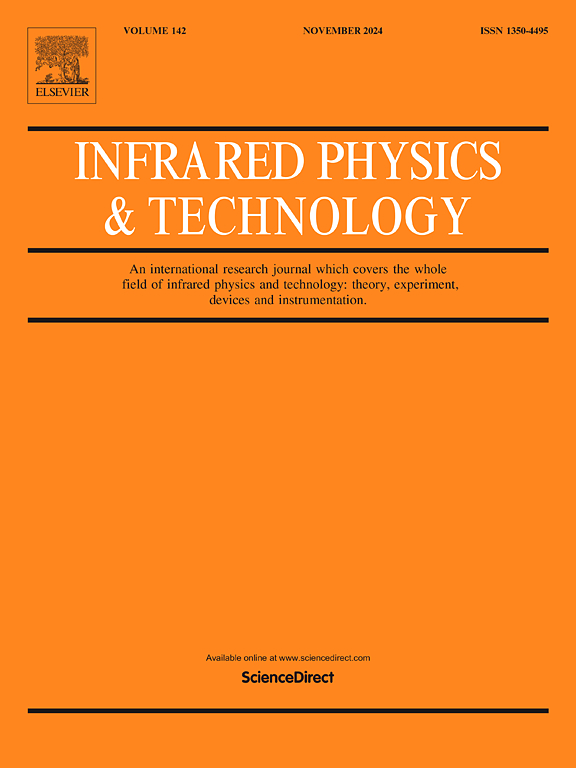Functional-film-modified SPR optical fiber sensor for dual-parameter detection in marine applications
IF 3.1
3区 物理与天体物理
Q2 INSTRUMENTS & INSTRUMENTATION
引用次数: 0
Abstract
The coating of semiconductor films with high Refractive Index (RI) can redshift the working band of the Ag-based Surface Plasmon Resonance (SPR) sensor. By utilizing semiconductor materials with distinct optical properties for coating, decoupled dual-parameter measurements can be achieved, enabling independent and distinguishable operating wavelengths for the two channels. This approach broadens the sensing bandwidth and enhances the detection range and sensitivity. This paper presents an SPR sensor based on no core fiber (NCF), which can measure salinity and temperature simultaneously in a complex Marine environment. The Ag/MgF2 composite film is used as the salinity sensing channel, where MgF2 provides excellent chemical stability to protect the Ag film and improve the sensitivity of the salinity channel. The Ag/TiO2/PDMS composite film, employed as a temperature sensing channel, significantly enhances the linearity and sensitivity of temperature measurements after thickness optimization. The high RI of TiO2 induces a substantial redshift in the operational wavelength, effectively separating it from the salinity sensing wavelength at around 700 nm, while simultaneously broadening the overall sensing bandwidth and expanding the temperature measurement range. Experimental results indicate that the maximum salinity sensitivity reaches 7 nm/% in the short-wavelength region, while the maximum temperature sensitivity is 4.5 nm/°C in the long-wavelength region. This study provides an innovative approach to the multi-functionalization and high sensitivity of SPR sensors through advanced film structure design, demonstrating significant potential for applications in marine monitoring and related fields.
船用双参数检测用功能膜改性SPR光纤传感器
高折射率(RI)半导体薄膜的涂层可以使银基表面等离子体共振(SPR)传感器的工作波段发生红移。通过利用具有不同光学特性的半导体材料进行涂层,可以实现去耦的双参数测量,从而实现两个通道的独立和可区分的工作波长。该方法拓宽了传感带宽,提高了检测范围和灵敏度。提出了一种基于无芯光纤(NCF)的SPR传感器,可以在复杂的海洋环境中同时测量盐度和温度。采用Ag/MgF2复合膜作为盐感通道,其中MgF2具有优异的化学稳定性,可以保护Ag膜,提高盐感通道的灵敏度。采用Ag/TiO2/PDMS复合薄膜作为温度传感通道,优化厚度后,温度测量的线性度和灵敏度显著提高。TiO2的高RI引起了工作波长的大量红移,有效地将其与700 nm左右的盐度传感波长分离,同时拓宽了整体传感带宽,扩大了温度测量范围。实验结果表明,在短波长区域,最大盐度灵敏度可达7 nm/%,而在长波长区域,最大温度灵敏度可达4.5 nm/°C。本研究通过先进的薄膜结构设计,为SPR传感器的多功能化和高灵敏度提供了创新途径,在海洋监测及相关领域具有重要的应用潜力。
本文章由计算机程序翻译,如有差异,请以英文原文为准。
求助全文
约1分钟内获得全文
求助全文
来源期刊
CiteScore
5.70
自引率
12.10%
发文量
400
审稿时长
67 days
期刊介绍:
The Journal covers the entire field of infrared physics and technology: theory, experiment, application, devices and instrumentation. Infrared'' is defined as covering the near, mid and far infrared (terahertz) regions from 0.75um (750nm) to 1mm (300GHz.) Submissions in the 300GHz to 100GHz region may be accepted at the editors discretion if their content is relevant to shorter wavelengths. Submissions must be primarily concerned with and directly relevant to this spectral region.
Its core topics can be summarized as the generation, propagation and detection, of infrared radiation; the associated optics, materials and devices; and its use in all fields of science, industry, engineering and medicine.
Infrared techniques occur in many different fields, notably spectroscopy and interferometry; material characterization and processing; atmospheric physics, astronomy and space research. Scientific aspects include lasers, quantum optics, quantum electronics, image processing and semiconductor physics. Some important applications are medical diagnostics and treatment, industrial inspection and environmental monitoring.

 求助内容:
求助内容: 应助结果提醒方式:
应助结果提醒方式:


